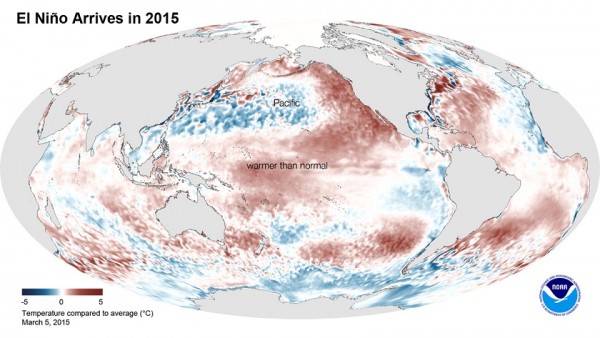El Niño Has Arrived But Will Not End California Drought
| Ana Verayo | | Mar 06, 2015 05:37 AM EST |
(Photo : NOAA) This image shows the average sea surface temperature for February 2015 as measured by NOAA satellites. The large area of red (warmer than average) can be seen extending through the equatorial Pacific.
El Niño has come to the Pacific Ocean and will bring warmer surface temperatures to the planet's biggest ocean.
Officials from NOAA (the National Oceanic and Atmospheric Administration) predict this long awaited event will apparently be mild this year and will have little effect on current weather patterns. Meteorologists, however, predict that even it's mild, El Niño can still bring wetter than normal conditions to the Gulf Coast in the U.S. in springtime.
Like Us on Facebook
According to Mike Halpert, deputy director of NOAA's Climate Prediction Center, El Niño is indeed here based on consistent observations of above average surface temperatures found on the western and central equatorial Pacific Ocean along with a steadfast pattern of sea level pressure.
This weak El Niño will also continue until summer based on climate prediction models.
This abnormal phenomenon is apparently being caused by forces and interactions between water and air formations in the equatorial region of the Pacific Ocean. NOAA officials predict there's a 50 to 60 percent chance El Niño conditions will carry-on until the summer months.
The report also states that this February, El Niño conditions were observed to manifest above average sea surface temperatures (SST) along the western and equatorial Pacific, which became weakly with tropical atmosphere.
El Niño is characterized by unusual warm surface temperatures in the central Pacific Ocean while its polar opposite El Niña is different with unusual colder temperatures in the region.
These two events are part of the El Niño-Southern Oscillation (ENSO) cycle, which is a fluctuation between temperature cycles found in the ocean and the atmosphere.
Each of them can typically last anywhere from nine to 12 months before normal Pacific temperatures resume.
When El Niño is stronger than usual, this can result in powerful rainstorms and hurricanes that can damage crops and even property along with infrastructure, and can also pose as a deadly threat to animals and even humans.
The last El Niño occurred between 2009 and 2010 and was stronger than climate scientists expected.
In 1997 and 1998, a powerful El Niño brought huge amounts of rain to California and other western states. This year's El Niño will be too weak as California is still experiencing an extended drought.
NOAA will still continue to monitor and study El Niño . The next NOAA report about El Niño will be published April 9.
TagsEl Niño Has Arrived But Will Not End California Drought, El Nino, NOAA, drought in california, US, Pacific Ocean, warmer ocean surface temperatures, El Niño drought california
©2015 Chinatopix All rights reserved. Do not reproduce without permission
EDITOR'S PICKS
-

Did the Trump administration just announce plans for a trade war with ‘hostile’ China and Russia?
-

US Senate passes Taiwan travel bill slammed by China
-

As Yan Sihong’s family grieves, here are other Chinese students who went missing abroad. Some have never been found
-

Beijing blasts Western critics who ‘smear China’ with the term sharp power
-

China Envoy Seeks to Defuse Tensions With U.S. as a Trade War Brews
-

Singapore's Deputy PM Provides Bitcoin Vote of Confidence Amid China's Blanket Bans
-

China warns investors over risks in overseas virtual currency trading
-

Chinese government most trustworthy: survey
-

Kashima Antlers On Course For Back-To-Back Titles
MOST POPULAR
LATEST NEWS
Zhou Yongkang: China's Former Security Chief Sentenced to Life in Prison

China's former Chief of the Ministry of Public Security, Zhou Yongkang, has been given a life sentence after he was found guilty of abusing his office, bribery and deliberately ... Full Article
TRENDING STORY

China Pork Prices Expected to Stabilize As The Supplies Recover

Elephone P9000 Smartphone is now on Sale on Amazon India

There's a Big Chance Cliffhangers Won't Still Be Resolved When Grey's Anatomy Season 13 Returns

Supreme Court Ruled on Samsung vs Apple Dispute for Patent Infringement

Microsoft Surface Pro 5 Rumors and Release Date: What is the Latest?










